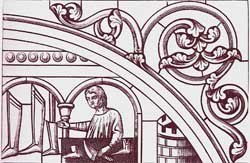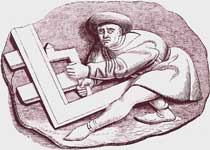Medieval Guilds
The Medieval Guilds are mentioned as early as the time of the first dynasty of the French kings, the Merovingians, when records are referring to the Corporation of Goldsmiths. Bakers were mentioned collectively in 630, under the reign of Dagobert. We may assume that associations of artisans were as ancient as the trades themselves, and that the members of the industrial classes, having to maintain and defend their common rights and common interests, would have sought to establish mutual fraternal associations among themselves.

A member of a Medieval Guild:
The boot maker apprentice
However, we can talk about a proper organization of the Medieval Guilds only in the 12th Century. Until then, they experienced a constant decline, and disappeared almost completely from the historical records. It was Italy which gave the signal for the resuscitation of the institutions whose birthplace was Rome.
Although previous to the 13th Century many of the corporations of artisans had been authorized by several of the kings of France to make special laws whereby they might govern themselves, it was really only from the reign of Saint Louis that the first general measures of administration and police relating to these communities can be dated.
In 1261 the King appointed Etienne Boileau, a rich bourgeois, provost of Paris. He ascertained from the verbal testimony of the senior members of each corporation (the future Guild) the customs and usages of the various crafts, which for the most part up to that date had not been committed to writing. He arranged and amended them, and then wrote the famous "Book of Trades." To a great extent this work is the genuine production of the corporations themselves, and not a list of rules established, framed and imposed by the authorities.
From that time the Middle Ages Guilds gradually introduced themselves into the order of society. The royal decrees in their favor were multiplied, and the regulations with regard to mechanical trades improved daily, not only in Paris and in the provinces, but also abroad, both in the south and the north of Europe, especially in Italy, Germany, England, and the Low Countries.
Etienne Boileau's book contained the rules of one hundred different Guilds or trade associations. However, some of the most important trades, such as butchers, tanners, glaziers were omitted, either because they neglected to register when Boileau's inquiry was made, or because some private interest kept them away from the registration, which probably imposed some sort of tax upon them. Besides various societies of artisans, in the Medieval Paris there were a few privileged Guilds which occupied a more important position, known under the name of "The Corps of Merchants". They comprised the drapers, which always took precedence of the others, the grocers, the mercers, the furriers, the hatters, and the goldsmiths.
The Medieval Guilds reached the height of their power in the 14th century. At that time, no association of artisans could legally existed without a license either from the King, the lord, the prince, the abbot, or the mayor of the district were they intended to establish themselves.
The organization of various Medieval trades in Guilds was governed by statutes, and the members enjoyed particular privileges. They were distinguished at public ceremonials by their special dress, as well by their arms and banners. They possessed the right to freely discuss their general interest, and at meetings composed of all the members of the Guild they might modify their statutes, provided that such changes were confirmed by the King or by authorities. To render the communications between members more easy, artisans of the same trade usually resided in the same quarter of the town, even on the same street.

Medieval carpenters had
their own Guild
The Medieval Guilds had the power of holding and administering property, of defending or bringing actions at law, or of accepting inheritances. Their treasury was supplied by legacies, donations, fines, and periodical subscriptions. In addition, through their jurors, the Guilds exercised a magisterial authority, and, under certain circumstances, even a criminal jurisdiction over their members.
The members of a corporation were divided into three distinct classes: the masters, the paid assistants or companions, and the apprentices. Within the Guilds of the Middle Ages there was a mutual assurance against misfortunes and injuries of all sorts, such as fire and shipwreck, and also against all lawsuits incurred for offences and crimes, even though they were proven against the accused. Each Guild had its chief or president chosen from among the members, and a common treasury supplied by annual contributions.
The statutes of the Medieval Guilds, which had the force of law on account of being approved and accepted by the King, almost always detailed with the greatest precision the conditions of labor. They fixed the days and hours of working, the size of articles to be made, the quality of stuff to be used in their manufacture, and even the price at which they were to be sold. Night labor was generally forbidden, as being likely to produce imperfect work.
Another important role of the Guild statute was to prevent frauds and falsifications. Masters were bound to put their trademark on their goods. It was also specified that a new master could not establish himself in the same street as his former master. No member was allowed to attract customers when they were nearer the shop of his neighbor than of his own.
It was usual for the corporations to assist those laid by through sickness, and to take care of the widows and orphans of the less prosperous craftsmen. They gave money and food to relieve the poor and presented the meat left from their banquets to the hospitals.
In the Middle Ages, religion placed its stamp on every occupation. The Medieval Guilds were careful to maintain this characteristic. As a result, each corporation was under the patronage of a saint, who was considered the special protector of the craft. Each Medieval Guild possessed a shrine or chapel in the church of the quarter where the trade was located.
